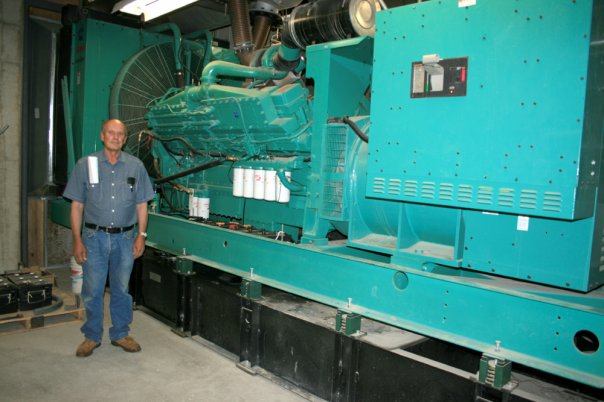|
|
 
|
|
Author
|
Topic: Generator sizing for d-cinema auditorium
|
|
|
|
|
|
|
Scott Norwood
Film God

Posts: 8146
From: Boston, MA. USA (1774.21 miles northeast of Dallas)
Registered: Jun 99
|
 posted 10-21-2019 08:30 PM
posted 10-21-2019 08:30 PM





There is more to this than just the generator.
Generators take some time to start and stabilize when power is cut. Generally, you would want the equipment to be on a UPS that would be capable of powering everything for a few minutes in order to allow the transfer to generator power to take place.
I have no idea what that would cost, but it would require a fairly mondo UPS. Also, most UPSes designed for computer equipment aren't really good at powering other things (most don't have a proper sine-wave output, for example).
The transfer switch is an important piece, and a possible point of failure.
Also, generators come in diesel and natural-gas varieties. Diesel has the benefit that it is not dependent upon the public gas supply (which might not survive an earthquake, for example), while natural gas has the benefit of not needing on-site fuel storage. For a cinema, natural-gas is the obvious choice, assuming that the building has gas available. Either type requires regular maintenance.
My only personal experience with this stuff is in a data-center environment, so I can't be more helpful, unfortunately.
The point about exit-signs and fire safety equipment above is a good one, too.
My guess is that keeping a cinema fully operational through a power outage probably won't be cost effective. A small generator for emergency lighting is probably a good idea, though, even if your local code doesn't specifically require it.
| IP: Logged
|
|
|
|
Marcel Birgelen
Film God
Posts: 3357
From: Maastricht, Limburg, Netherlands
Registered: Feb 2012
|
 posted 10-22-2019 03:33 AM
posted 10-22-2019 03:33 AM




I've done datacenter related work for many years. It is something you really need to work out with a bunch of trained experts. For datacenters it's pretty simple: everything except the cooling needs to be on UPS and everything needs to be on the generator. But consider a hospital, stuff becomes a lot more complicated already, making the correct sizing of emergency power systems much harder.
If you don't want to be able to light up your entire building but just sections of it during a power outage, then it's going to be quite complicated as you really need to decide what systems you're going to need and what not. You essentially would need to adapt your internal wiring for this. It's hard to know the complexity of that, without having a complete overview.
Then there are the systems you really need to have on a no-break/UPS system and those you can live without for a few minutes. Since you probably can't afford to redo your whole wiring, you would need to work with smaller UPS units around your building.
Stuff you probably want to put on a UPS besides your servers and projectors are also the lamps of your projectors as a show will be seriously hurt when the lamp of your projector goes out. Then there is the sound. Do you accept people sitting in complete silence for a minute or two? Or do you want to put the sound system on UPS too? Depending on the wattage, those are already quite some beefy UPS systems you need for that alone. Also keep in mind that putting in stacks of batteries around your building creates extra fire hazards. Talk with somebody of your local fire brigade about it, they often don't like those distributed UPS systems or they require something like a central "emergency off' switch for them, as those autonomous systems pose a serious risk for electrical shocks for them.
Then there are also the "backbone systems" like switches, TMS and other server systems, like PoS systems. The same may be true for your box office and concession PoS systems.
Then what do you want to do with your lightning? You probably have an emergency lightning system that takes over once the power drops out, but putting your lightning on the generator is an absolute requirement. You can ask yourself if putting it on UPS is a requirement too, because I've noticed that lights going out will generally cause a little panic. If you have switched your lightning to LED entirely, putting it on UPS will be far cheaper, but still, it adds up.
Don't forget systems like airco and/or heating. Especially air-conditioners are power hungry beasts, but you probably don't want to run without them. The same goes for heating, even if you're using e.g. gas for heating, don't forget that heating units themselves, ventilation and pumping systems will all require quite some electrical power. You don't need to put them on a UPS, but you need to account for it when sizing your generator.
Sizing the generator, in the end is pretty easy. Simply run everything you need and you can reliably "shed" when the power drops at maximum performance and measure what you need. Add at least 30% for comfort and that's what the generator needs to give.
Another thing to consider, when installing a generator, is the amount of fuel it can store. Although most systems can be refueled while they're running, in my experience, expensive contracts that guarantee a refill within x hours are often worthless. If the shit hits the fan, you'll see that those companies are totally over-stressed and there's always an excuse of not getting to you in time, often those excuses are legitimate, like a flooded road, etc. So, having a fuel reserve of at least 48 hours is pretty crucial in my opinion.
Last but not least: procedures and testing.
You need to have the proper procedures in place and you need to test your setup regularly. You shouldn't be afraid to eventually do this while you're open. You should be confident that your emergency power works the way it should work, even if you're not around yourself pulling the levers. The best way to do it, is to regularly run on those systems. The first few times you'll be switching over to emergency power, you'll find those many little things you haven't thought about. After you've done it a few times, stuff should start to go smooth.
Also, switching back from generator power to the net is something that needs to be thought about. Do you switch back automatically or manually? How do you know your feed is sufficiently stable to accept your load?
Lots of things to think about.
Off course, if you're talking about planned outages, you can plan ahead and do a more orderly transition, but make sure your emergency power system doesn't come back to bite you. You're adding lots of new components, components that can be operated wrongly and components that can break. I've seen those systems fail and facilities go dark, while their external feeds never went off-line...
Maybe you think that I'm dramatizing it a bit, but I've been there. ![[Wink]](wink.gif)
| IP: Logged
|
|
Jack Ondracek
Film God

Posts: 2348
From: Port Orchard, WA, USA
Registered: Oct 2002
|
 posted 10-22-2019 09:57 AM
posted 10-22-2019 09:57 AM





A lot of this is good information, but much is related to specific functions.
In my parallel field (broadcast engineering), I maintain generators at transmitter and studio locations. In both cases, there isn't much that's unusual or specific to the industry. Critical equipment, such as office computers and rack-room gear are backed up by UPSs until the generator spins up and takes over. Any generator I have over 40kW has a block heater that keeps it moderately warm. Those units are up, ready to go and on load within 10 seconds of the time the power goes down.
In some smaller stations that suffer infrequent, short-term outages, Generac home-type generators work quite well. They take a bit longer to run up, because they don't start on a hair trigger. Even then, they are on-line within 20 seconds.
I have had a generator at my drive-in for over 20 years. It has actually been on-line with customers only 6 times or so. Each time however, I had nearly 1,200 people on the property. That's a lot of passes, missed cheeseburgers and unfulfilled expectations... and few places are as inky dark at night as a drive-in in the middle of nowhere. In my opinion, even having saved only those evenings, the generator has been well worth the investment. One winter, we were down for 3 days, due to numerous power poles being dropped by ice. In that case, the generator kept our house and walk-in coolers at temperature, and we lost nothing.
When ACE installed my digital gear, they put in two Tripp-Lite UPSs on each screen; one 240 volt unit for each projector (Barco 23 and 32b's) and a 120 volt unit for the server and network equipment. My lamps are not on UPS and go down until the generator takes over, but restart quickly. All of my other computers (POS, audio processing, etc) are on UPSs. The exit lights are LED-based and have their own batteries.
In my case, the only catch was to up-size the generator enough that it could manage the starting current required to spin up the 3-phase compressors I have on my walk-in cooler and freezer. Everything else was able to be easily measured by a clamp-on ammeter.
As for running a generator in California... good luck with that one. A friend of mine down there is the operations manager for a small group of radio stations. He says the paperwork & permitting required to run a generator in California is typical of the bureaucratic absurdity that prevails there.
| IP: Logged
|
|
|
|
|
|
|
|
Marcel Birgelen
Film God
Posts: 3357
From: Maastricht, Limburg, Netherlands
Registered: Feb 2012
|
 posted 10-23-2019 02:15 AM
posted 10-23-2019 02:15 AM




Instead of buying a generator, there is also the possibility of renting one. The last time I did such a calculation, the rental prices for a heavier model wasn't all that much higher, so it made sense to put the whole building on a generator. This also saved us the headache of adapting the internal power grid.
It's not really easy to do a general estimate of the power consumption of a single auditorium, as there are so many variables that come into play.
Below, I made an estimation of an average sized room, seating about 150 to 200 people, but I may be overestimating or even forgetting some important factors.
Server: 0.5kW
Projector: 0.5kW
Lamp: 5kW (based on 4kW lamp + overhead)
Automation and other doodads: 0.5kW
Audio system: 6kW (based on 10 amps @500W + overhead)
Other audio components: 0.5kW
Booth Airconditioning and ventilation: 4kW
Room lightning: 2kW
Room cooling: 15kW
Total: 34kW
Let's assume a Power factor of 0.7, then this would require about 48 kVA without any overhead margin.
It's obvious that this is based on a lot of assumptions. Like the lamp in the projector, the amount of cooling needed, which is very dependent on the climate and the sizing of the audio system, which is also very dependent on the size of the auditorium. The same goes for stuff like auditorium lightning. Are you already using LED everywhere? How bright is it in there? Do you use any kind of power hungry special lightning?
Also, the Power factor is something pretty specific to your situation, although I guess that 0.7 is a worst-case scenario in the case of a modern cinema auditorium.
Those estimations are based on peak usage of all systems concurrently. In practice this doesn't happen very often, but you still have to design for it. You know, that hot summer night, where everybody flocked to your cool theater to watch the latest uber-loud blockbuster in 3D...
| IP: Logged
|
|
|
|
|
|
All times are Central (GMT -6:00)
|
|
Powered by Infopop Corporation
UBB.classicTM
6.3.1.2
The Film-Tech Forums are designed for various members related to the cinema industry to express their opinions, viewpoints and testimonials on various products, services and events based upon speculation, personal knowledge and factual information through use, therefore all views represented here allow no liability upon the publishers of this web site and the owners of said views assume no liability for any ill will resulting from these postings. The posts made here are for educational as well as entertainment purposes and as such anyone viewing this portion of the website must accept these views as statements of the author of that opinion
and agrees to release the authors from any and all liability.
|

 Home
Home
 Products
Products
 Store
Store
 Forum
Forum
 Warehouse
Warehouse
 Contact Us
Contact Us




 Printer-friendly view of this topic
Printer-friendly view of this topic










![[Wink]](wink.gif)





